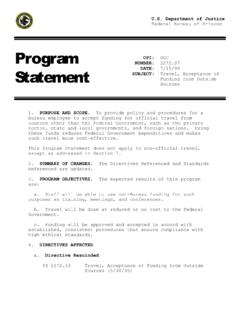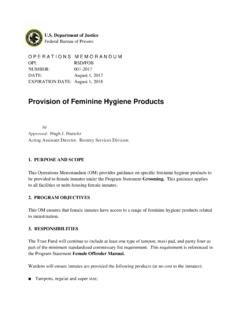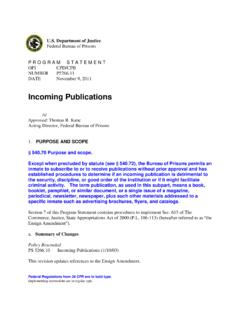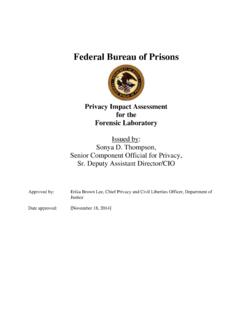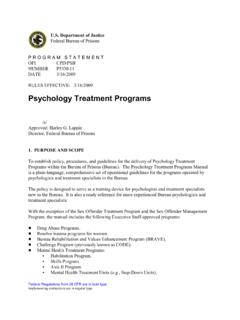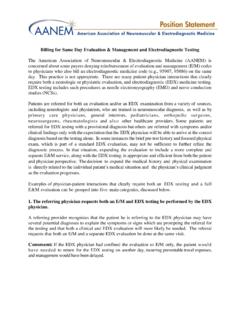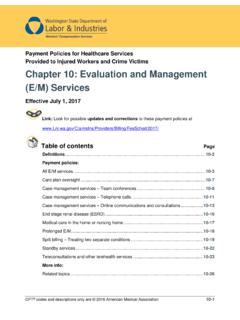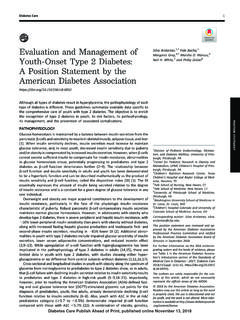Transcription of Evaluation and Management of Chronic Hepatitis C Virus ...
1 Evaluation AND Management OF Chronic Hepatitis C Virus (HCV) INFECTION federal bureau of Prisons Clinical Guidance JANUARY 2018 federal bureau of Prisons (BOP) Clinical Guidance is made available to the public for informational purposes only. The BOP does not warrant this guidance for any other purpose, and assumes no responsibility for any injury or damage resulting from the reliance thereof. Proper medical practice necessitates that all cases are evaluated on an individual basis and that treatment decisions are patient-specific. Consult the BOP Health Management Resources Web page to determine the date of the most recent update to this document: bureau of Prisons Evaluation and Management of Chronic HCV Infection Clinical Guidance January 2018 i WHAT S NEW IN BOP GUIDANCE REGARDING HCV INFECTION?
2 The current version of this guidance contains the following major revisions: Two new combination DAA medications have been FDA-approved for the treatment of chronichepatitis C Virus (HCV) infection and are now included in Section 6, Recommended TreatmentRegimens: Glecaprevir/pibrentasvir (Mavyret ) and Sofosbuvir/velpatasvir/voxilaprevir (Vosevi ). Recommended HCV treatment regimens have been updated to reflect the current guidance fromthe American Association for the Study of Liver Diseases (AASLD). The APRI cutoff for treatment Priority Level 2 has been lowered to The appendices containing drug information tables are no longer included in this light of the rapidly changing HCV treatment landscape, providers are now refered to manufacturer sprescribing information, Facts and Comparisons (available in BEMR), and other validated resourcesfor the most up-to-date information on individual HCV bureau of Prisons Evaluation and Management of Chronic HCV Infection Clinical Guidance January 2018 ii TABLE OF CONTENTS 1.
3 PURPOSE AND OVERVIEW .. 1 2. SCREENING FOR HCV INFECTION .. 2 Inmate History and Patient Education .. 2 Screening 2 Screening Method .. 3 Screening of Nonsentenced Inmates .. 3 Refusal of Testing .. 3 3. INITIAL Evaluation OF ANTI-HCV POSITIVE 4 Baseline Evaluation .. 4 4. ASSESS FOR HEPATIC CIRRHOSIS AND DECOMPENSATION .. 5 Assessing for Hepatic Fibrosis and Cirrhosis .. 6 Assessing Hepatic Compensation .. 7 TABLE 1: Using CTP Scores to Assess Hepatic Compensation .. 7 Additional Interventions for Inmates with Cirrhosis .. 7 5. BOP PRIORITY CRITERIA FOR HCV TREATMENT .. 8 Priority Level 1: High Priority for Treatment *.
4 8 Priority Level 2: Intermediate Priority for Treatment * .. 9 Priority Level 3: Low Priority for Treatment * .. 9 Other Criteria for Treatment .. 9 6. RECOMMENDED TREATMENT REGIMENS .. 10 Direct Acting Antiviral Medications (DAAs) .. 10 Preferred Treatment Regimens .. 14 Potential Drug Interactions .. 14 Regimens Not Recommended .. 15 7. MONITORING .. 15 Pretreatment Assessment .. 15 On-Treatment 16 Post-Treatment Monitoring .. 17 Ongoing Monitoring .. 17 8. SPECIAL CONSIDERATIONS .. 18 HCV Infection with More Than One Genotype .. 18 HBV Coinfection .. 18 HIV Coinfection .. 18 Decompensated Cirrhosis.
5 19 TABLE 2: HCV Treatment Recommendations for Decompensated Cirrhosis .. 20 Liver Transplant Recipients .. 21 TABLE 3: HCV Treatment Recommendations for HCV in Liver Transplant 21 Chronic Kidney Disease (CKD) .. 22 Pregnancy .. 22 REFERENCES .. 24 GLOSSARY OF 25 federal bureau of Prisons Evaluation and Management of Chronic HCV Infection Clinical Guidance January 2018 iii APPENDIX 1. TREATMENT OPTIONS FOR HCV GENOTYPES 1, 4, 5, AND 6A,B,C .. 26 APPENDIX 2. TREATMENT OPTIONS FOR HCV GENOTYPES 2 AND 3 A,B,C .. 27 APPENDIX 3. Hepatitis C TREATMENT MONITORING SCHEDULE .. 28 APPENDIX 4.
6 Management OF HEMATOLOGIC CHANGES .. 29 APPENDIX 5. RESOURCES PREVENTION AND TREATMENT OF VIRAL Hepatitis .. 30 APPENDIX 6. Hepatitis C TREATMENT ALGORITHM/NONFORMULARY REQUEST WORKSHEET .. 31 federal bureau of Prisons Evaluation and Management of Chronic HCV Infection Clinical Guidance January 2018 1 AND OVERVIEWThe federal bureau of Prisons (BOP) Clinical Guidance on Evaluation and Management of Chronic Hepatitis C Virus (HCV) Infection provides the most current BOP recommendations for the treatment of Chronic HCV infection in the federal inmate population. As stated by the current American Association for the Study of Liver Diseases (AASLD)/Infectious Diseases Society of America (IDSA) HCV Guidance, the goal of treatment of HCV-infected persons is to.
7 Reduce all-cause mortality and liver-related health adverse consequences, including end-stage liver disease and hepatocellular carcinoma, by the achievement of virologic cure as evidenced by a sustained virologic response. In light of the rapidly changing HCV treatment landscape, review of the most recent recommendations from AASLD/IDSA (see link below) is recommended. BOP Central Office Medical staff will continue to monitor this guidance and provide updates as necessary. Be sure to consult the BOP Health Management Resources website to determine the date of the most recent update to this document: The AASLD/IDSA guidance is available at See the References section in this document for a complete citation.
8 In general, the BOP promotes a modified test-and-treat strategy for HCV infection. The BOP-recommended approach to Evaluation and Management of HCV includes five basic steps. STEP 1: Test for HCV infection with anti-HCV (HCV Ab) test. See Section 2, Screening for HCV Infection. All sentenced inmates Diagnostic Evaluation of other conditions Upon inmate requestSTEP 2: Perform a baseline Evaluation of inmates who are anti-HCV positive. See Section 3, Initial Evaluation of Anti-HCV Positive Inmates. Targeted history and physical exam Lab tests CBC, PT/INR, liver panel, serum creatinine and eGFR, Hepatitis B serology(HBsAg, anti-HBs, anti-HBc), HIV Ab, quantitative HCV RNA viral load with reflex testing forHCV genotypeSTEP 3: Assess for hepatic cirrhosis/compensation and BOP priority criteria for treatment, if HCV RNA is detectable.
9 Assess for hepatic cirrhosis/compensation: Calculate APRI score if no obvious cirrhosis;Calculate CTP score if cirrhosis is known or suspected ( Section 4). Assess for BOP priority criteria for treatment of HCV ( Section 5).STEP 4: Perform a pretreatment assessment, if priority criteria for treatment are met. Determine the most appropriate DAA regimen(s) DAA regimen selection is based on HCV genotype, cirrhosis, compensated oruncompensated liver disease, prior treatment history, presence of resistance associatedsubstitutions, and drug interactions ( Appendix 1 and Appendix 2). Refer to AASLD HCV guidance, DHHS antiretroviral guidelines, and manufacturers prescribing information for specific drug interactions ( References).
10 Obtain pretreatment labs within 90 days of starting treatment ( Appendix 3). Submit Nonformulary Request (NFR) for Hepatitis C Treatment Algorithm; if approved, submitNFR(s) for specific DAA medication(s) ( Appendix 6). Provide preventive health care for patients with 5: Monitor patient during and after treatment. Start treatment with approved DAA regimen. Follow monitoring schedule described in Appendix bureau of Prisons Evaluation and Management of Chronic HCV Infection Clinical Guidance January 2018 2 FOR HCV INFECTIONINMATE HISTORY AND PATIENT EDUCATION A health history should be obtained from all newly incarcerated BOP inmates.
